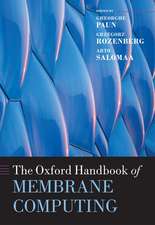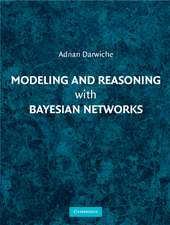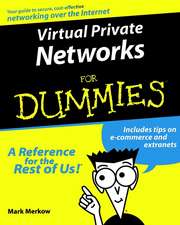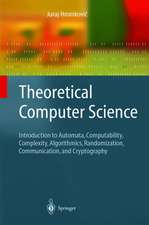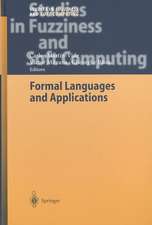Introduction to Pattern Recognition: A Matlab Approach
Autor Sergios Theodoridis, Aggelos Pikrakis, Konstantinos Koutroumbas, Dionisis Cavourasen Limba Engleză Paperback – 30 apr 2010
It includes Matlab code of the most common methods and algorithms in the book, together with a descriptive summary and solved examples, and including real-life data sets in imaging and audio recognition.
This text is designed for electronic engineering, computer science, computer engineering, biomedical engineering and applied mathematics students taking graduate courses on pattern recognition and machine learning as well as R&D engineers and university researchers in image and signal processing/analyisis, and computer vision.
- Matlab code and descriptive summary of the most common methods and algorithms in Theodoridis/Koutroumbas, Pattern Recognition, Fourth Edition
- Solved examples in Matlab, including real-life data sets in imaging and audio recognition
- Available separately or at a special package price with the main text (ISBN for package: 978-0-12-374491-3)
Preț: 183.18 lei
Preț vechi: 253.95 lei
-28% Nou
Puncte Express: 275
Preț estimativ în valută:
35.06€ • 38.07$ • 29.45£
35.06€ • 38.07$ • 29.45£
Carte tipărită la comandă
Livrare economică 15-29 aprilie
Preluare comenzi: 021 569.72.76
Specificații
ISBN-13: 9780123744869
ISBN-10: 0123744865
Pagini: 240
Ilustrații: 1
Dimensiuni: 191 x 235 x 15 mm
Greutate: 0.41 kg
Editura: Elsevier
ISBN-10: 0123744865
Pagini: 240
Ilustrații: 1
Dimensiuni: 191 x 235 x 15 mm
Greutate: 0.41 kg
Editura: Elsevier
Public țintă
Electrical engineering, computer science, computer engineering, biomedical engineering and applied mathematics students taking graduate courses on pattern recognition and machine learning. R&D engineers and university researchers in image and signal processing/analyisis, and computer vision.Cuprins
Preface Chapter 1. Classifiers Based on Bayes Decision Theory 1.1 Introduction 1.2 Bayes Decision Theory 1.3 The Gaussian Probability Density Function 1.4 Minimum Distance Classifiers 1.4.1 The Euclidean Distance Classifier 1.4.2 The Mahalanobis Distance Classifier 1.4.3 Maximum Likelihood Parameter Estimation of Gaussian pdfs 1.5 Mixture Models 1.6 The Expectation-Maximization Algorithm 1.7 Parzen Windows 1.8 k-Nearest Neighbor Density Estimation 1.9 The Naive Bayes Classifier 1.10 The Nearest Neighbor RuleChapter 2. Classifiers Based on Cost Function Optimization 2.1 Introduction 2.2 The Perceptron Algorithm 2.2.1 The Online Form of the Perceptron Algorithm 2.3 The Sum of Error Squares Classifier 2.3.1 The Multiclass LS Classifier 2.4 Support Vector Machines: The Linear Case 2.4.1 Multiclass Generalizations 2.5 SVM: The Nonlinear Case 2.6 The Kernel Perceptron Algorithm 2.7 The AdaBoost Algorithm 2.8 Multilayer PerceptronsChapter 3. Data Transformation: Feature Generation and Dimensionality Reduction 3.1 Introduction 3.2 Principal Component Analysis 3.3 The Singular Value Decomposition Method 3.4 Fisher's Linear Discriminant Analysis 3.5 The Kernel PCA 3.6 Laplacian EigenmapChapter 4. Feature Selection 4.1 Introduction 4.2 Outlier Removal 4.3 Data Normalization 4.4 Hypothesis Testing: The t-Test 4.5 The Receiver Operating Characteristic Curve 4.6 Fisher's Discriminant Ratio 4.7 Class Separability Measures 4.7.1 Divergence 4.7.2 Bhattacharyya Distance and Chernoff Bound 4.7.3 Measures Based on Scatter Matrices 4.8 Feature Subset Selection 4.8.1 Scalar Feature Selection 4.8.2 Feature Vector SelectionChapter 5. Template Matching 5.1 Introduction 5.2 The Edit Distance 5.3 Matching Sequences of Real Numbers 5.4 Dynamic Time Warping in Speech RecognitionChapter 6. Hidden Markov Models 6.1 Introduction 6.2 Modeling 6.3 Recognition and TrainingChapter 7. Clustering 7.1 Introduction 7.2 Basic Concepts and Definitions 7.3 Clustering Algorithms 7.4 Sequential Algorithms 7.4.1 BSAS Algorithm 7.4.2 Clustering Refinement 7.5 Cost Function Optimization Clustering Algorithms 7.5.1 Hard Clustering Algorithms 7.5.2 Nonhard Clustering Algorithms 7.6 Miscellaneous Clustering Algorithms 7.7 Hierarchical Clustering Algorithms 7.7.1 Generalized Agglomerative Scheme 7.7.2 Specific Agglomerative Clustering Algorithms 7.7.3 Choosing the Best ClusteringAppendixReferencesIndex


